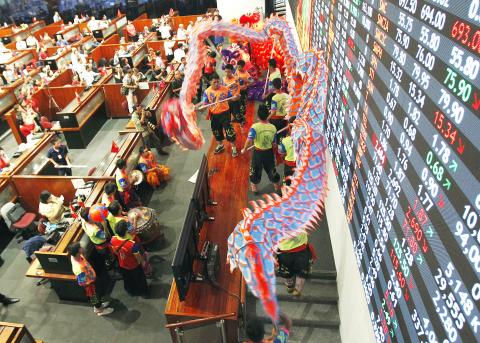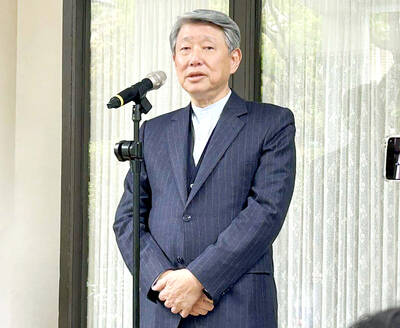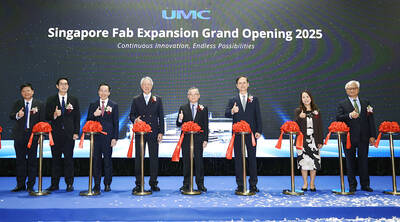Asian markets sank further in holiday-thinned trade yesterday, following another global sell-off caused by anxieties over emerging markets and further disappointing manufacturing data out of China.
The euro edged up against the yen after falling in New York in response to weak eurozone inflation figures that added to fears of deflation in the currency bloc.
Tokyo fell 1.98 percent, or 295.40 points, to 14,619.13 and Seoul slipped 1.09 percent, or 21.19 points, to 1,919.96.

Photo: Reuters
Sydney closed flat, edging down 2.1 points to 5,187.9 while Wellington eased 0.51 percent, or 25.08 points, to 4,849.50.
However, Bangkok was up 1.10 percent despite chaotic weekend elections that saw thousands of polling stations closed by opposition protestors following weeks of anti-government demonstrations.
Taipei, Shanghai, Hong Kong, and Kuala Lumpur were closed for the Lunar New Year holiday.
Global equities tanked last week after the US Federal Reserve said it would further cut its stimulus program, sparking fears of a flight of capital from developing nations while also sending their currencies falling against the US dollar.
That in turn was fueling buying of the yen, which was being viewed as safe haven, and that was helping send regional stocks lower, Toyo Securities Co strategist Hiroaki Hiwada said.
The stock fall in New York was also weighing on investor sentiment, he said.
“There is little good news to trade on. Maybe by next week, people will start to buy shares back,” Hiwada said.
On Friday the Dow sank 0.94 percent, the S&P 500 fell 0.65 percent and the NASDAQ lost 0.47 percent.
Earlier in Europe the FTSE 100 in London ended 0.43 percent lower, Frankfurt’s DAX 30 dropped 0.71 percent and the CAC 40 in Paris slid 0.34 percent.
The euro was little changed at US$1.3485. The US dollar rose to ¥102.23 from ¥101.96 late on Friday, but is down from about ¥105 at the beginning of the year.
“There’s still some nervousness about emerging markets,” investment adviser Christopher Macdonald told Dow Jones Newswires. “People are wondering if the jitters we saw last month are a sign of some bigger dislocation in the market.”
Adding to the downbeat outlook was official data from China pointing to a slowdown in manufacturing activity in the world’s second-largest economy and key driver of global growth.
The purchasing managers’ index (PMI) fell to 50.5 last month from 51 in December last year and 51.4 in November, the Chinese National Bureau of Statistics and the China Federation of Logistics and Purchasing said on Saturday.
Any figure above 50 indicates expansion while anything below signals contraction.
The news came days after banking giant HSBC’s China PMI came in at a six-month low of 49.5.
“There is no doubt that the surging money-market rates have added uncertainty and dampened industry confidence,” said Liu Li-gang (劉利剛), chief Greater China economist at Australia & New Zealand Banking Group Ltd in Hong Kong.
The Chinese central bank will “have to strike a delicate balance” between cracking down on shadow banking and maintaining financial stability, Liu said.
A separate report released yesterday on the non-manufacturing sector also showed a deterioration, with that PMI falling to 53.4 last month from 54.6 in December last year.

MULTIFACETED: A task force has analyzed possible scenarios and created responses to assist domestic industries in dealing with US tariffs, the economics minister said The Executive Yuan is tomorrow to announce countermeasures to US President Donald Trump’s planned reciprocal tariffs, although the details of the plan would not be made public until Monday next week, Minister of Economic Affairs J.W. Kuo (郭智輝) said yesterday. The Cabinet established an economic and trade task force in November last year to deal with US trade and tariff related issues, Kuo told reporters outside the legislature in Taipei. The task force has been analyzing and evaluating all kinds of scenarios to identify suitable responses and determine how best to assist domestic industries in managing the effects of Trump’s tariffs, he

TIGHT-LIPPED: UMC said it had no merger plans at the moment, after Nikkei Asia reported that the firm and GlobalFoundries were considering restarting merger talks United Microelectronics Corp (UMC, 聯電), the world’s No. 4 contract chipmaker, yesterday launched a new US$5 billion 12-inch chip factory in Singapore as part of its latest effort to diversify its manufacturing footprint amid growing geopolitical risks. The new factory, adjacent to UMC’s existing Singapore fab in the Pasir Res Wafer Fab Park, is scheduled to enter volume production next year, utilizing mature 22-nanometer and 28-nanometer process technologies, UMC said in a statement. The company plans to invest US$5 billion during the first phase of the new fab, which would have an installed capacity of 30,000 12-inch wafers per month, it said. The

Taiwan’s official purchasing managers’ index (PMI) last month rose 0.2 percentage points to 54.2, in a second consecutive month of expansion, thanks to front-loading demand intended to avoid potential US tariff hikes, the Chung-Hua Institution for Economic Research (CIER, 中華經濟研究院) said yesterday. While short-term demand appeared robust, uncertainties rose due to US President Donald Trump’s unpredictable trade policy, CIER president Lien Hsien-ming (連賢明) told a news conference in Taipei. Taiwan’s economy this year would be characterized by high-level fluctuations and the volatility would be wilder than most expect, Lien said Demand for electronics, particularly semiconductors, continues to benefit from US technology giants’ effort

‘SWASTICAR’: Tesla CEO Elon Musk’s close association with Donald Trump has prompted opponents to brand him a ‘Nazi’ and resulted in a dramatic drop in sales Demonstrators descended on Tesla Inc dealerships across the US, and in Europe and Canada on Saturday to protest company chief Elon Musk, who has amassed extraordinary power as a top adviser to US President Donald Trump. Waving signs with messages such as “Musk is stealing our money” and “Reclaim our country,” the protests largely took place peacefully following fiery episodes of vandalism on Tesla vehicles, dealerships and other facilities in recent weeks that US officials have denounced as terrorism. Hundreds rallied on Saturday outside the Tesla dealership in Manhattan. Some blasted Musk, the world’s richest man, while others demanded the shuttering of his